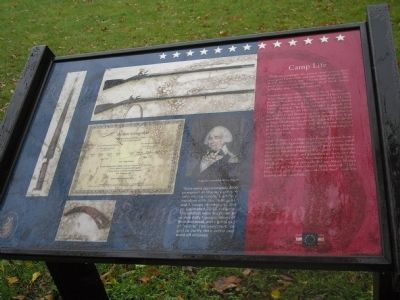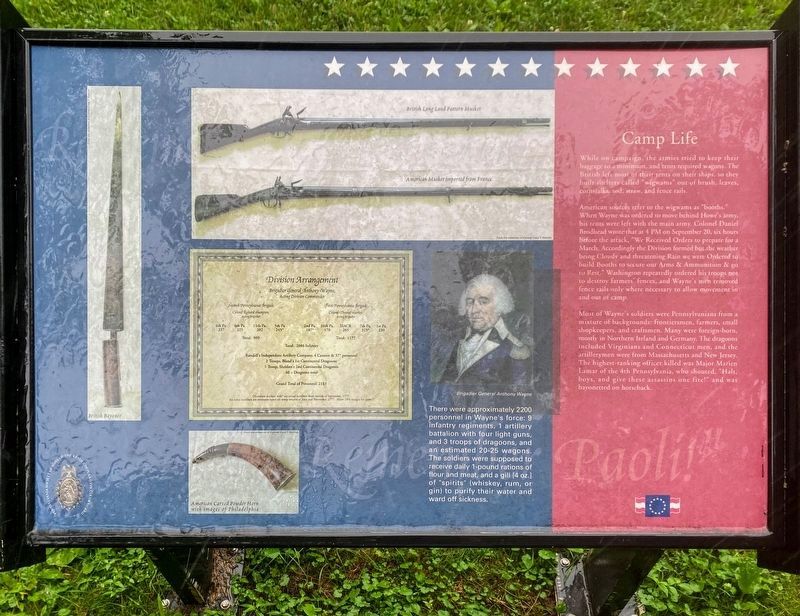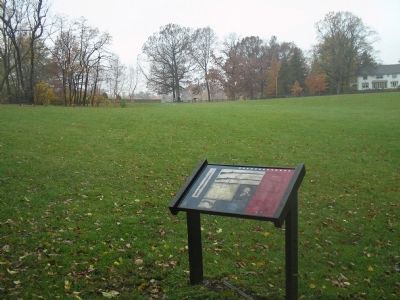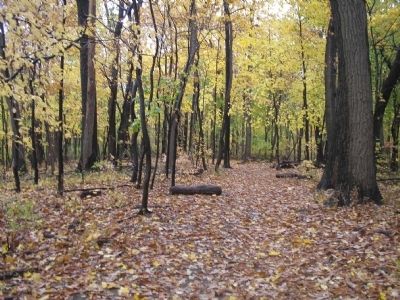Malvern in Chester County, Pennsylvania — The American Northeast (Mid-Atlantic)
Camp Life
American sources refer to the wigwams as “booths.” When Wayne was ordered to move behind Howe’s army, his tents were left with the main army. Colonel Daniel Brodhead wrote that at 4 PM on September 20, six hours before the attack, “We Received Orders to prepare for a March. Accordingly the Division formed but the weather being Cloudy and threatening Rain we were Ordered to build Booths to secure our Arms & Ammunition & go to Rest.” Washington repeatedly ordered his troops not to destroy farmers’ fences, and Wayne’s men removed fence rails only where necessary to allow movement in and out of camp.
Most of Wayne’s soldiers were Pennsylvanians from a mixture of backgrounds: frontiersmen, farmers, small shopkeepers, and craftsmen. Many were foreign born, mostly in Northern Ireland and Germany. The dragoons included Virginians and Connecticut men, and the artillerymen were from Massachusetts and New Jersey. The highest ranking officer killed was Major Marien Lamar of the 4th Pennsylvania, who shouted, “Halt, boys, and give these assassins one fire!” and was bayoneted on horseback.
There were approximately 2200 personnel in Wayne’s force: 9 infantry regiments, 1 artillery battalion with four light guns, and 3 troops of dragoons, and an estimated 20-25 wagons. The soldiers were supposed to receive daily 1-pound rations of flour and meat, and a gill [4 oz.] of “spirits” (whiskey, rum, or gin) to purify their water and ward off sickness.
Topics. This historical marker is listed in these topic lists: Notable Places • War, US Revolutionary. A significant historical month for this entry is September 1764.
Location. 40° 1.788′ N, 75° 31.005′ W. Marker is in Malvern, Pennsylvania, in Chester County. Marker can be reached from Monument Avenue, on the left when traveling west. Marker is on the Paoli Battlefield. Touch for map. Marker is in this post office area: Malvern PA 19355, United States of America. Touch for directions.
Other nearby markers. At least 8 other markers are within walking distance of this marker. "Losing a wheel and crashing into a gap in the fence line"... (within shouting distance of this marker); General Wayne’s Encampment (within shouting distance of this marker); "…The most dreadful scene I have ever beheld." (within shouting distance of this marker); The Land on Which the Battle of Paoli was Fought (about 300 feet away, measured in a direct line); “A Dreadful scene of havock” (about 300 feet away); The Paoli Battlefield (about 400 feet away); Battlefield Site Map (about 500 feet away); This Wall (about 500 feet away). Touch for a list and map of all markers in Malvern.
More about this marker. The marker contains a portrait of Brigadier General Anthony Wayne, a Division Arrangement by Acting Division Commander Brigadier General Anthony Wayne, and various weapons that would have been found around camp, including a British Long Land Pattern Musket, an American Musket imported from France, a British Bayonet and an American carved powder horn with images of Philadelphia.
Related markers. Click here for a list of markers that are related to this marker. This series of markers follow the walking trail of the Paoli Battlefield.
Also see . . .
1. Background to the Battle of Paoli. Paoli Battlefield website. (Submitted on November 16, 2008, by Bill Coughlin of Woodland Park, New Jersey.)
2. The Battle of Paoli (Massacre) September 21, 1777 at Malvern, Pennsylvania. The American Revolutionary War website. (Submitted on November 16, 2008, by Bill Coughlin of Woodland Park, New Jersey.)
3. The Battle of Paoli also known as the Paoli Massacre. A British perspective of the battle from BritishBattles.com (Submitted on November 16, 2008, by Bill Coughlin of Woodland Park, New Jersey.)
Credits. This page was last revised on May 21, 2021. It was originally submitted on November 16, 2008, by Bill Coughlin of Woodland Park, New Jersey. This page has been viewed 914 times since then and 14 times this year. Photos: 1. submitted on November 16, 2008, by Bill Coughlin of Woodland Park, New Jersey. 2. submitted on May 12, 2021, by Shane Oliver of Richmond, Virginia. 3, 4. submitted on November 16, 2008, by Bill Coughlin of Woodland Park, New Jersey.



